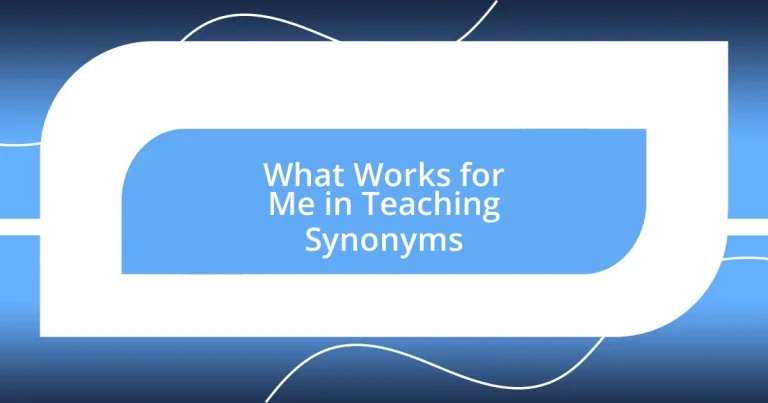Key takeaways:
- Teaching synonyms enhances vocabulary, critical thinking, and confidence in language use, allowing students to express themselves more effectively.
- Engaging strategies such as word webs, synonym games, and real-life activities like scavenger hunts make learning synonyms interactive and enjoyable.
- Assessing synonym understanding through quizzes, peer assessments, and reflective journaling helps ensure comprehension of context and emotional nuance in word choices.
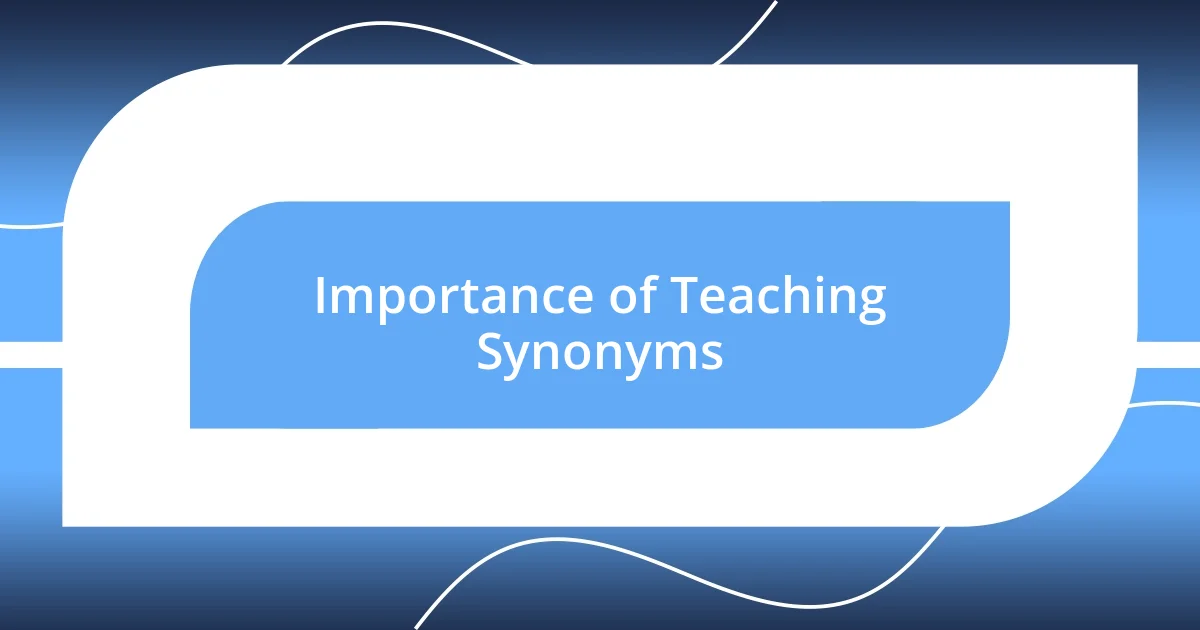
Importance of Teaching Synonyms
Teaching synonyms is crucial because it enriches students’ vocabulary and enhances their ability to express themselves. I remember a moment when a struggling student used the word “happy” over and over in her writing. When we explored synonyms together, her excitement as she discovered words like “joyful” and “elated” was palpable. It was a reminder of how small changes can significantly impact understanding and expression.
Moreover, synonyms foster critical thinking skills by encouraging students to consider context and nuance. Have you ever noticed how subtle differences in word choice can alter meaning? When teaching synonyms, I often ask students how the mood of a sentence shifts with different terms. It’s fascinating to see their eyes light up as they realize the power they hold through their word choices.
Lastly, the practice of learning synonyms promotes confidence in language use. I distinctly remember one student who, after mastering a set of synonyms, boldly participated in class discussions. It was like watching a flower bloom. The knowledge of alternatives gave him the assurance to express his thoughts more freely, and it’s moments like these that truly highlight the importance of teaching synonyms in a meaningful way.
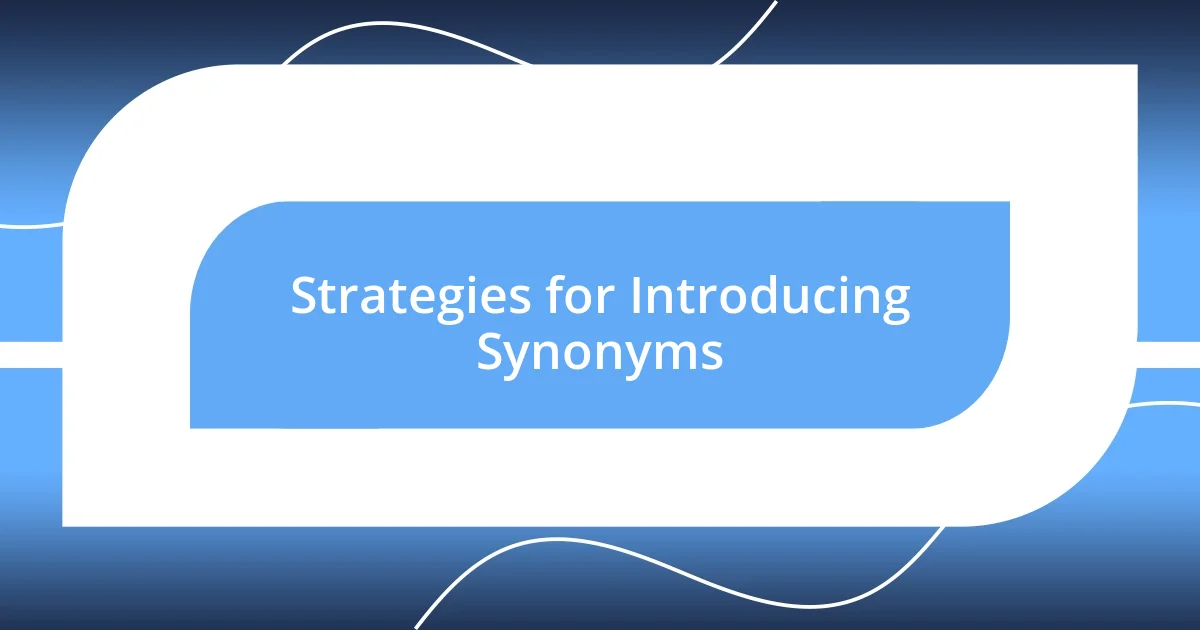
Strategies for Introducing Synonyms
To successfully introduce synonyms in the classroom, I find that using relatable examples works wonders. For instance, I often start by sharing a personal story about how a specific word once held me back from expressing a complex feeling. When I used the word “sad,” I realized it lacked the depth I wanted. I then asked my students for their own experiences with limited vocabulary, fostering a connection and emphasizing the importance of expanding their language. This personal exchange not only warms up the group but also sets the stage for why synonyms matter.
Here are some strategies that have proven effective for me:
- Word Webs: I ask students to create visual maps, starting with a target word like “angry,” branching out to synonyms such as “furious,” “irate,” and “enraged.” This visual representation helps cement connections in their minds.
- Synonym Games: Incorporating fun games like synonym bingo or matching activities keeps students engaged while reinforcing their learning.
- Story Rewriting: I provide a short story and ask students to replace specific words with synonyms, encouraging creativity and critical thinking.
- Contextual Usage: I have students write sentences using new synonyms, illustrating how meaning can shift based on word choice.
- Classroom Discussions: Engaging the class in discussions about synonyms in popular songs or books sparks excitement and helps them recognize synonyms in real-world contexts.
Emphasizing these strategies not only enriches vocabulary but also makes language learning a dynamic and enjoyable experience.
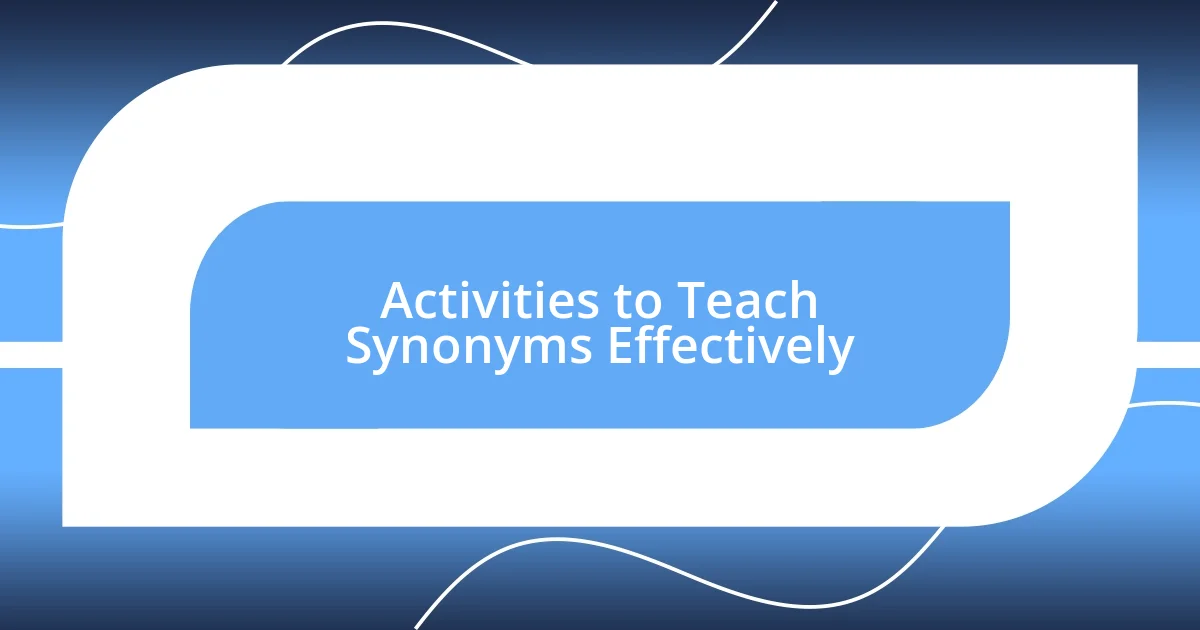
Activities to Teach Synonyms Effectively
One of my favorite activities to teach synonyms effectively is the “Synonym Swap.” It’s a simple but effective exercise where students write a short paragraph using a common word multiple times. Afterward, they pair up and challenge each other to swap out those words for synonyms. I still recall how thrilled one student was when she transformed her bland paragraph into a colorful narrative filled with expressive alternatives. It’s a fantastic way to include peer interaction and see firsthand how synonyms can elevate writing.
Another engaging activity involves “Synonym Pictionary,” where students draw pictures that represent specific words and their synonyms. This was particularly memorable in my classroom when a student creatively illustrated “quick” with a lightning bolt and “swift” with a bird. Watching them connect visuals with vocabulary reinforced their understanding and made learning memorable. Using their creativity not only reinforces the words but also builds excitement in the classroom.
I also enjoy incorporating real-life contexts with the activity “Synonym Scavenger Hunt.” I send students on a mission to find a list of objects around the classroom and write down synonyms for each. The first time I tried this, I was astounded at how actively engaged everyone became—we ended up with a colorful list that included “lively” for “energetic” and “sophisticated” for “elegant.” This hands-on approach rooted the concept of synonyms in tangible experiences, making it more relatable and fun for my students.
| Activity | Description |
|---|---|
| Synonym Swap | Students replace common words in their paragraphs with synonyms through peer interaction. |
| Synonym Pictionary | Students draw visuals representing words and their synonyms, fostering creativity and understanding. |
| Synonym Scavenger Hunt | Students find classroom objects and write synonyms, connecting vocabulary to tangible experiences. |
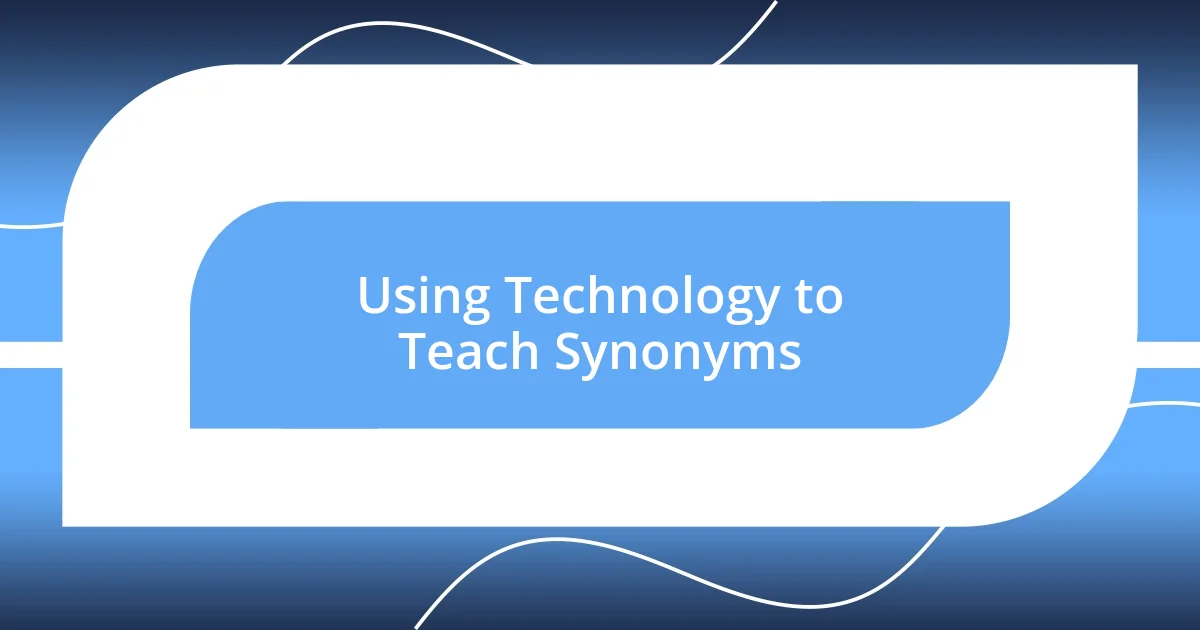
Using Technology to Teach Synonyms
Using technology in the classroom has transformed the way I teach synonyms. I often utilize interactive platforms like Quizlet, which allows students to engage with synonyms through flashcards and games. One day, I noticed a particularly shy student light up while competing in a synonym matching game; it was incredible to see her confidence soar as she correctly identified pairs. Doesn’t it feel rewarding when students find joy in learning?
Another tool I love is online brainstorming apps like Padlet, where students can collaboratively list synonyms in real-time. I vividly remember a moment when my class was brainstorming synonyms for “happy.” The enthusiasm was palpable as students contributed words like “joyful,” “elated,” and even “ecstatic.” Watching their ideas flow and build off each other’s contributions was a fantastic reminder of the power of collaboration in learning. Have you ever witnessed such vibrant energy during a lesson?
Lastly, I’ve found that incorporating multimedia resources, such as videos from platforms like YouTube, offers dynamic ways to explain synonyms. For instance, I showed a clip from a popular animated movie that highlighted the use of synonyms in dialogue. The laughter and engagement that followed were priceless and really drove the point home about how varied word choice can enhance storytelling. Isn’t it fascinating how visual and auditory cues can deepen our understanding of language?
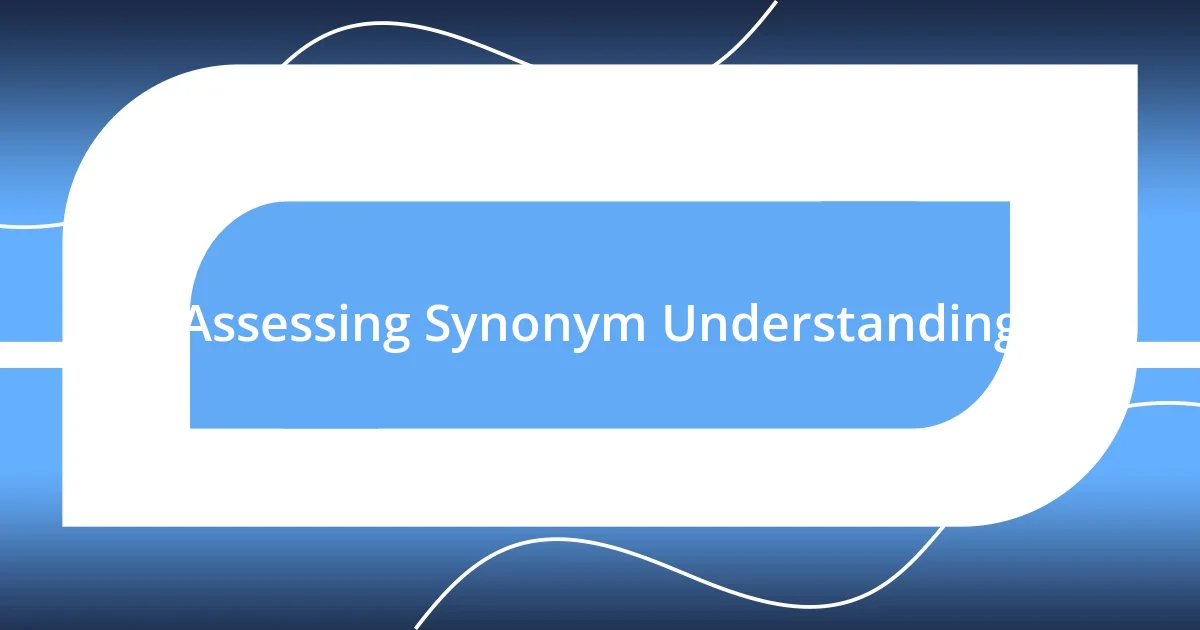
Assessing Synonym Understanding
Assessing synonym understanding is crucial to ensure that students don’t just memorize words but also grasp their meanings and contexts. One effective method I use is creating synonym quizzes where students must choose the correct synonym in context. I remember one student, during a quiz, confidently selected “happy” over “cheerful” in a sentence. This small victory showed me she understood not just the words but the subtle emotional nuances behind them.
I also implement peer assessments, encouraging students to evaluate each other’s work to identify and discuss synonym usage. It’s eye-opening to see how they articulate their thoughts on their peers’ choices. I recall a moment where a student explained why they selected “joyful” instead of “content.” This discussion revealed their deeper comprehension and highlighted how collaborative learning could enhance understanding. Isn’t it amazing to realize how much insight can emerge from student interactions?
Moreover, I find that simple reflection exercises, where students write down their favorite synonyms and why they resonate with them, can provide valuable insight into their understanding. When I first tried this, a student shared that he loved “courageous” because it reminded him of a hero in a book he adored. This emotional connection was a powerful indicator of his engagement and grasp of the concept. How often do we overlook these personal connections in learning, yet they can be so revealing?
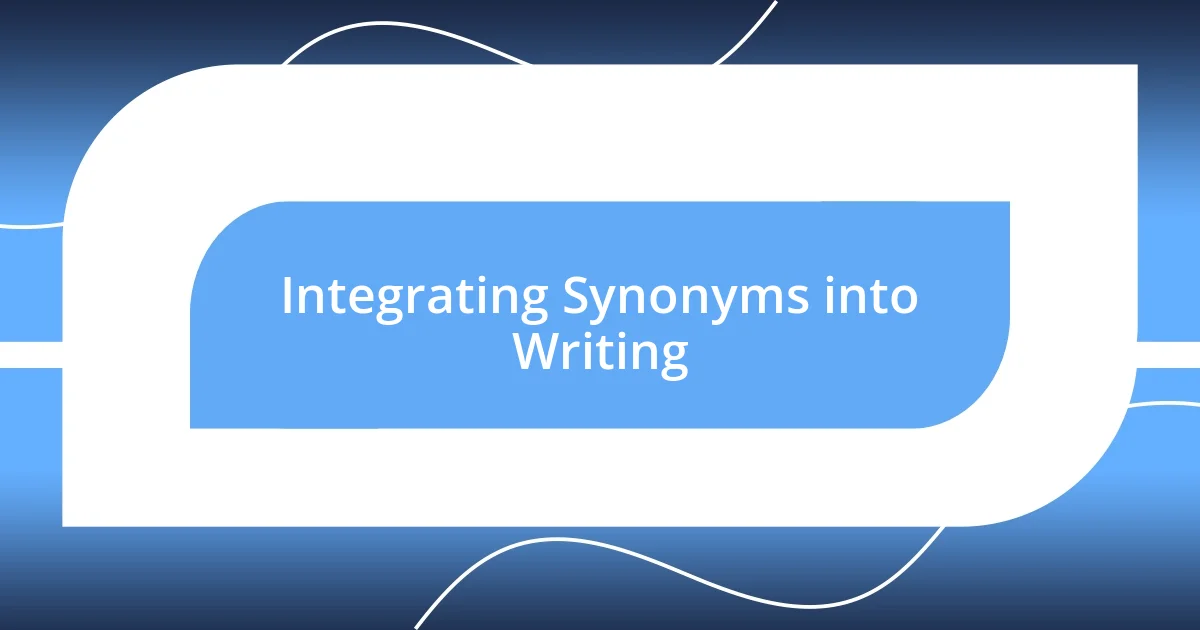
Integrating Synonyms into Writing
When I integrate synonyms into students’ writing, I often encourage them to experiment with word choice in a fun and constructive way. One activity I particularly love is the “synonym swap,” where students rewrite sentences with different synonyms. I recall one student transforming the sentence “The dog ran fast” into “The dog sprinted quickly.” The excitement on his face when he realized he could elevate his writing with just a slight change was a game changer. Isn’t it incredible how the right word can make a whole sentence sing?
Another powerful strategy involves reflective journaling. I have my students maintain a synonym journal where they can recount their day using a variety of synonyms. One day, a student wrote about “a delightful afternoon filled with joy and merriment” instead of just saying “a fun day.” The way she infused her personal experience with diverse vocabulary illuminated her growth and creativity, reminding me how writing can be a joyful expression of one’s thoughts. Have you ever experienced that moment when a student discovers their unique voice through choice of words?
To deepen this practice further, I often highlight the importance of context. During writing workshops, I ask students to consider how a synonym can change the tone of a piece. I remember a student who initially described a character as “angry” but later chose “furious” after understanding the emotional weight it carries. Witnessing that lightbulb moment in her comprehension was truly gratifying. How much richness can we bring to writing simply by choosing the right synonyms that resonate with our feelings?
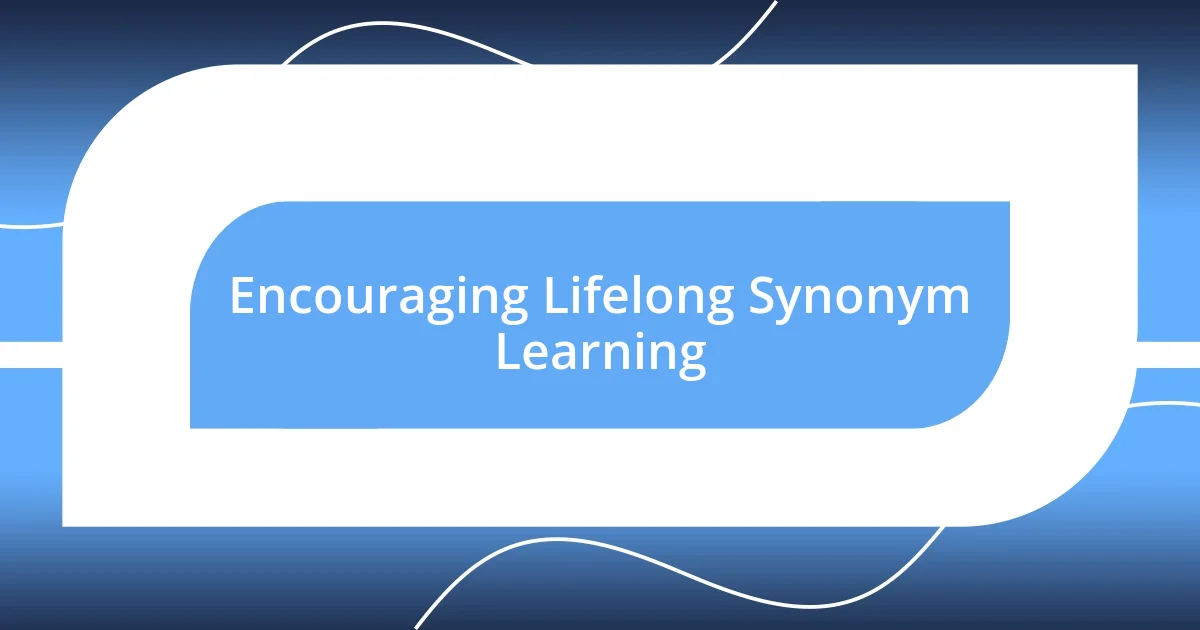
Encouraging Lifelong Synonym Learning
Encouraging lifelong synonym learning is about more than just vocabulary—it’s about fostering a mindset that values language diversity. I often encourage my students to embrace word exploration as part of their daily lives. For instance, I challenge them to find a new synonym each day, jotting it down in a dedicated notebook. One student shared that naming specific synonyms allowed them to see the world through a fresh lens. Can you imagine how empowering it feels when language opens up new ways to express thoughts?
In addition, I promote the use of playfulness in discovering synonyms. During one of our enrichment classes, I introduced a game where students had to come up with a synonym for common phrases within a time limit. The laughter and creativity that ensued were infectious. A particularly quiet student surprised everyone by suggesting “glorious” for “great,” and I saw a spark ignite within him. Isn’t it fascinating how games can cultivate not just language skills but also confidence?
I also advocate for the idea that learning synonyms should extend beyond the classroom into real-world applications. I remember encouraging my students to pay attention to synonyms in their favorite books or TV shows, which sparked some vibrant discussions. One student remarked how it enhanced their understanding of character emotions as they dissected a scene, noting the varied language choices. When language becomes part of their everyday conversations, isn’t that when it really sticks?











